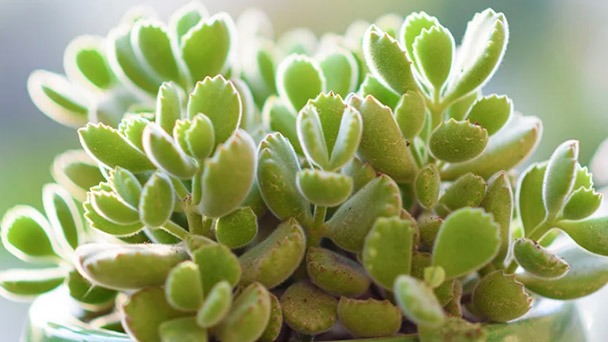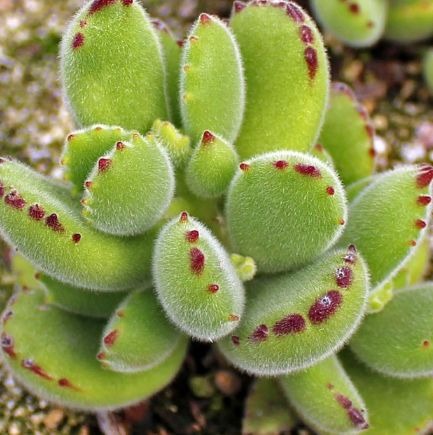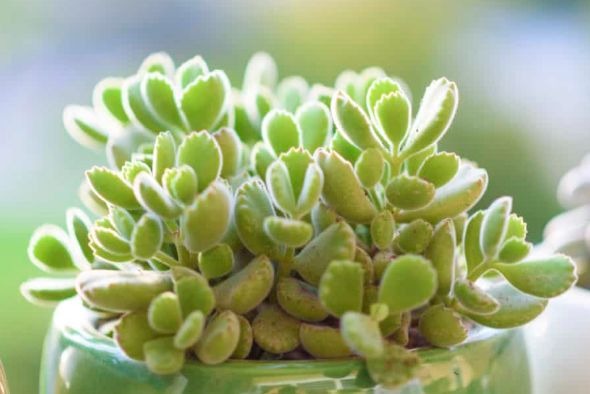Bear Paw Succulent Care - The Ultimate Guide (2023)
Written by Ivy
Jan 10 2023

A bright, shady location where the Bear Paw Succulent's tiny paws won't receive excessive direct sunlight Overwatering can easily harm bear paw succulents since they are a very delicate species of plant. In order to avoid water ponding after rain or irrigation, think about planting them in slightly sandy, well-drained soil.
What is a Bear Paw Succulent?

The fuzzy foliage of the bear paw (Cotyledon tomentosa) is squat and chubby with upper tips that resemble an animal's foot or paw. It has dark red edges. The attractive shrub-like plant is highlighted by the dark red that appears when the plant is slightly stressed and makes the shape stand out. Its leaves get chubbier as more water is held in them, making it small and delicate. One indoor plant that is suggested for those who are new to growing plants indoors is the succulent bear paw. Tomentosa is a botanical term that refers to something that is fuzzy or covered in short, matted, dense hairs. The phrase will probably appear next to other botanical plant names. It's not as difficult to grow succulent plants with fuzzy leaves as many people believe. The most important thing is to water the plant's roots and, if at all possible, keep the foliage dry. This is sound advice for watering all succulents.
Bear Paw Succulent Care
Sun
South Africa is the original home of the Cotyledon tomentosa. They develop in a dry, well-lit environment there.
The paws of bears prefer lots of light. Give your bear paw plant as much light as you can inside. It receives about six hours of indirect sunlight per day in the best location, a bright south-facing window.
The leaves' tips take on a deep red hue when exposed to intense sunlight.
Bear paw succulents can grow in lower light, but the color or any variegation may fade, and the growth will get leggy and slow down.
Consider purchasing a grow light if you have access to sufficient light.
Stay out of the sun. These could scorch and burn the delicate leaves. Remove your plant from the window, or use a sheer curtain to block the light.
Watering
In terms of watering, cotyledon tomentosa is probably similar to any other succulents; they enjoy having their roots sopped but need time to dry out. Particularly during the summer or when there isn't any rain, give them routine deep watering. To keep your pet's paws healthy, give them at least one ¼ cup of water per smaller paw and one to one ½ cup per large paw each week.
Only water potted Bear's Paw when the soil is completely dry. Take out the accumulated water from the saucer once the soil has been thoroughly saturated and the water has completely drained from the porosity in their pot.
The plants don't need a lot of water in the winter because they go dormant. Simply give them a drink at least once every other week to prevent the soil from drying out completely and your Bear's Paw from withering.
Water from the bottom or with a watering can with a long spout. You only need to add water to a bowl or cachepot to accomplish this. Placing your bear paw inside will allow it to absorb the water through the drainage holes in the pot's base.
Don't mist your succulent bear paw. It prefers dry air and doesn't require humidity.
While the plant is dormant in the winter, water it sparingly. Just enough water should be applied to prevent the soil from drying out completely and the leaves from turning brown.
Feeding
When it comes to fertilization, Cotyledon Tomentosa doesn't require much care, particularly in an extremely cold climate. However, during their active growth phase, which occurs in the spring and summer, they require feeding at least twice per month, which typically occurs from the month of April to August. At this time, give them a light, balanced, all-purpose water-soluble fertilizer for succulents.
Soil
Because they are prone to root rot, Cotyledon Tomentosa require a well-draining soil mixture. Use a specially formulated soil for cacti and succulents, or mix perlite and coarse sand into regular potting soil. (Read More: What Is Succulent Root Rot)
They typically thrive in slightly acidic soil with a pH of around 6, and they grow well in pots that are just one size larger than the root system.
When to Repot a Bear Paw Succulent
Succulents with bears paws don't require repotting all that frequently. Repot when roots have clogged the pot to the point where it is root-bound; you will typically notice roots emerging from the drainage holes on the bottom.
Even if there is still room for growth, repot your plant every two to three years. The soil will need to be replaced with new, nutrient-replete, well-draining soil that is succulent. To aid with drainage, pumice or perlite can be added.
The spring season is the ideal time to repot your bear paw. It will be in the best shape to handle being repotted at the start of the growing season.
Before applying fertilizer, you should wait at least four to six months after repotting. Usually, fertilizer is included in the potting mix.
Bear Paw Succulent Propagation
Stem cuttings are the best method for multiplying bear paw succulents. Although it is possible, single leaves rarely succeed in reproduction.
Make sure to completely callous over stem cuttings before planting them in water for propagation. And have patience, as the emergence of roots can take some time. In general, soil-based propagation is more efficient and effective.
Propagate Cuttings in Water
Propagating bear paw stem cuttings in water is simple and takes only a few steps.
- Take a stem cutting that has a few leaf sets or more. Get rid of the bottom leaves.
- Allow the cutting to callus and dry for about two to three days.
- Just enough water should be added to the glass vessel to cover the bottom of the cuttings.
- Maintain it in direct light that is bright.
- Make sure to change the water regularly
- Seek out the appearance of roots.
Before you pot them up, let the roots grow to a length of about one to two inches. Once you've watered, wait until you notice new growth before watering again.

Propagate Bear Paw Soils in Soil
This benevolent, attractive houseplant can be multiplied from seeds. The easiest method is seed propagation. The potting soil must be mixed with the seeds before planting. Just make sure that the surrounding weather is conducive to growth, including the appropriate level of sunlight, temperature, etc. Utilize artificial lighting for growth if you decide to propagate indoors.
Propagate Bear Paw Cuttings in Soil
Another way to propagate your bear paw succulent is to plant the cuttings straight in soil.
- Take a stem cutting that has a few leaf sets or more. Take out the lower leaves.
- Allow the cutting to callus and dry for about two to three days.
- Cover the area of your cutting where the bottom leaves were removed with the potting soil.
- Place the cuttings in indirect light and water very lightly
- Hold off until fresh growth appears. You can resume your regular care at this point.
While your plant is establishing itself, try to avoid disturbing it. If you must, give the plant a very slight tug. If you encounter resistance, roots are establishing themselves in the ground. Simply avoid doing this too frequently.
You can apply a rooting hormone powder to your cuttings to hasten the process. Before planting, dip the cuttings in rooting powder and then water, covering the bottom 1/4 inch of each.
Common Problems for Bear's Paw Succulent
1. Pests/insects on Bear's Paw
Their leaves, like those of the majority of the Crassulaceae family, are very attractive to pests, particularly cochineal. Because of the silver hair on their leaves, these pests are easily missed, making routine inspections crucial.
Mealybugs, spider mites, and scale are the main sources of infection for Bear's Paw. Mealybugs typically appear as waxy white insects at the base of leaves and stems. Apply a cotton swab dipped in rubbing alcohol to the pests to quickly eradicate them. Alcohol kills the pests by dissolving their protective coating.
Scale insects are quite tough and can be found on the Bear's paw stems. They are easily removed using a fingernail.
2. Overwatered
Like with most succulents, it's important to be aware of fungus diseases brought on by excessive watering. Easily collapsible hobbled leaves (bear's paw leaves have a tendency to do this; use extra caution when handling them) could be a sign of this.
3. Cold Hardiness
In zones 9b to 11b, Cotyledon tomentosa can withstand the cold. They cannot be left outside in colder climates; instead, they must be cared for like a houseplant. To keep your Bear's Paw healthy, just make sure it receives enough light. In the summer, you can move them outside.
Is a Bear Paw Succulent Plant Toxic to Pets?
The Cotyledon tomentosa is considered mildly toxic when ingested.
The majority of pets won't go near the fuzzy leaves, but if yours likes to eat plants, keep this one out of their reach!
Serious injury from eating plants is incredibly uncommon in cats or dogs. Finding out what kind of plant you are bringing home requires research at all times, though.
Where to Buy Bear Paw Succulents
To choose a bear paw succulent, go to your neighborhood plant nursery or garden center. They typically take the best care of their plants, giving you and your plant the best chance of success at home.
Whenever you shop for plants, keep in mind the advice on how to pick the best one.
There are some plant growers who sell them on Amazon if you can't find one nearby.

Bottom Line
In conclusion, Bear's Paw makes a very attractive standalone plant in pots and can be a real eye-catcher when combined with your other plant collections, but one still needs to give them extra care for them to continually thrive and grow healthy. The aforementioned advice will assist you in obtaining a pair of incredibly endearing little paws.
FAQs
Do Bear Paw Succulents Bloom Indoors?
Bear paw succulents can bloom and grow flowers indoors if their conditions are just right and they are receiving plenty of light.
They typically start to grow in the spring. If your bear paw doesn't bloom, don't worry. It's true of many indoor succulents.
The flowers come in light yellow, pink, and orange and have a pretty bell shape.
Why is My Bear Paw Dropping Leaves?
Are your bear paw succulent's leaves suddenly falling off? Your bear paw losing an old leaf as new ones emerge is common. Look into it if more than a single leaf occasionally falls off.
Lower leaves turning yellow and then dropping off are usually a sign of overwatering. The most typical reason for leaf drop is this.
Lack of sunlight can also cause leaves to fall off.
If the leaves start to dry out and shrivel up before they fall off, the plant is probably underwatered and needs a good soak.
Why My Bear Paw Succulent Turning Yellow
Yellow leaves on a bear paw succulent are usually because the plant has been overwatered. especially if it is combined with mushy brown stems or falling leaves.
Wait to water until the soil has dried out, then adjust your watering schedule going forward.
If the ground is completely soggy, you might need to replace the soil. To dispose of any extra water, make sure the pot has drainage holes on the bottom.
Why My Bear Paw Plant Growing Leggy
As the plant matures, your bear paw succulent should develop compact pairs of leaves.
If your bear paw is growing leggy and leaning to one side, it is seeking and stretching for more light. Bring it closer to a window or use a plant grow lamp to prevent it from becoming lanky.
Latest Updated
- Benefits of Bugleweed - 7 Science-backed Health Benefits
- Bugleweed Dangers & Side Effects - Is It Poisonous?
- How to Plant Evergreen Trees - What You Should Know
- When to Plant Evergreens - Grow Guide for Evergreen Trees
- 12 Wonderful Evergreen Shrubs for Your Garden
- 12 Popular Evergreen Plants with Pictures for Beginners
- When And How To Prune A Lilac Bush Like a Pro
- How to Grow & Care for Lilac Vine (Hardenbergia Violacea)
- Japanese Lilac Tree (Syringa Reticulata) Care & Propagation Guide
- Shumard Oak Pros and Cons - What to Know
Popular Articles
- Winter maintenance of Antirrhinum Majus
- How to Grow Terminalia Mantaly Tree
- How to Grow and Care for Crossostephium Chinense
- How to grow Antirrhinum Majus in spring
- Peristeria Elata (Dove Orchid) Profile: Info & Care Guide
- Underwatered Snake Plant (Sansevieria Trifasciata) - Signs And How To Fix
- How to Care for Brazilian Jasmine Plant (Mandevilla Sanderi)
- How to Grow & Care for Graptopetalum Purple Delight in Summer
- Rosa Chinensis (China Rose): Plant Growing & Care Tips
- How to Care for Baby Sun Rose (Aptenia Cordifolia)